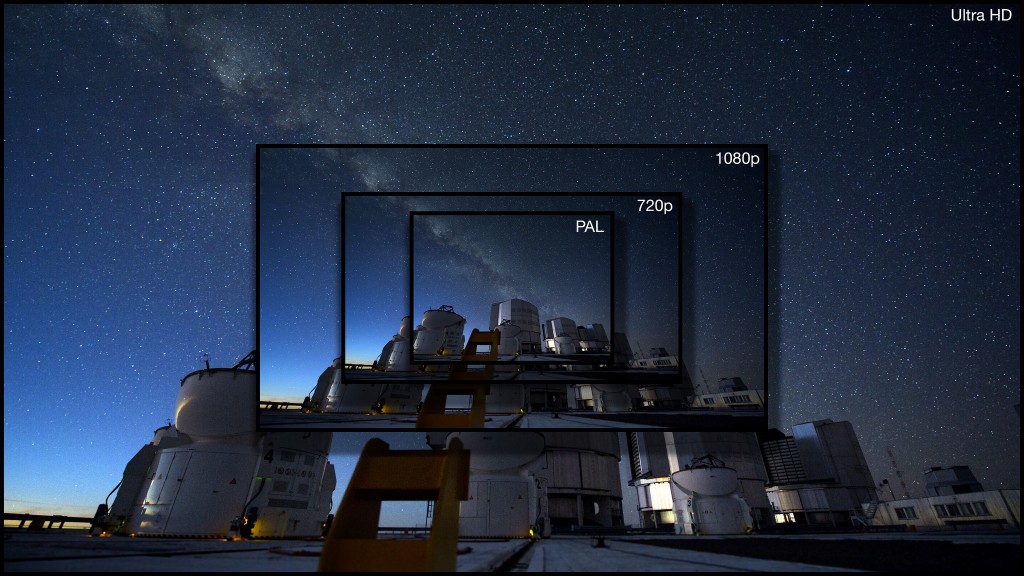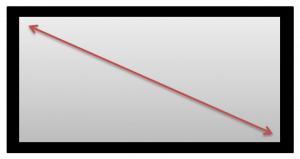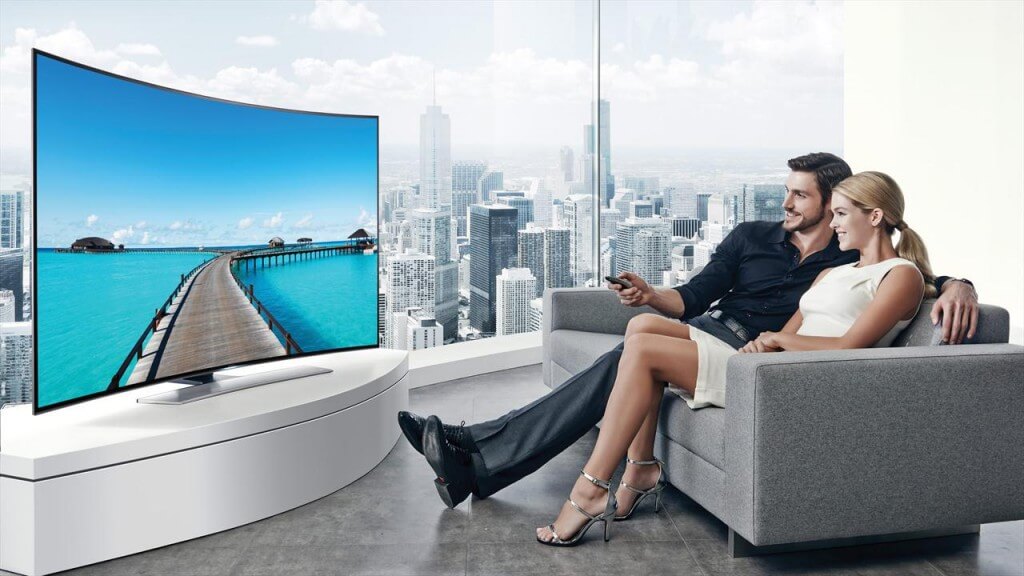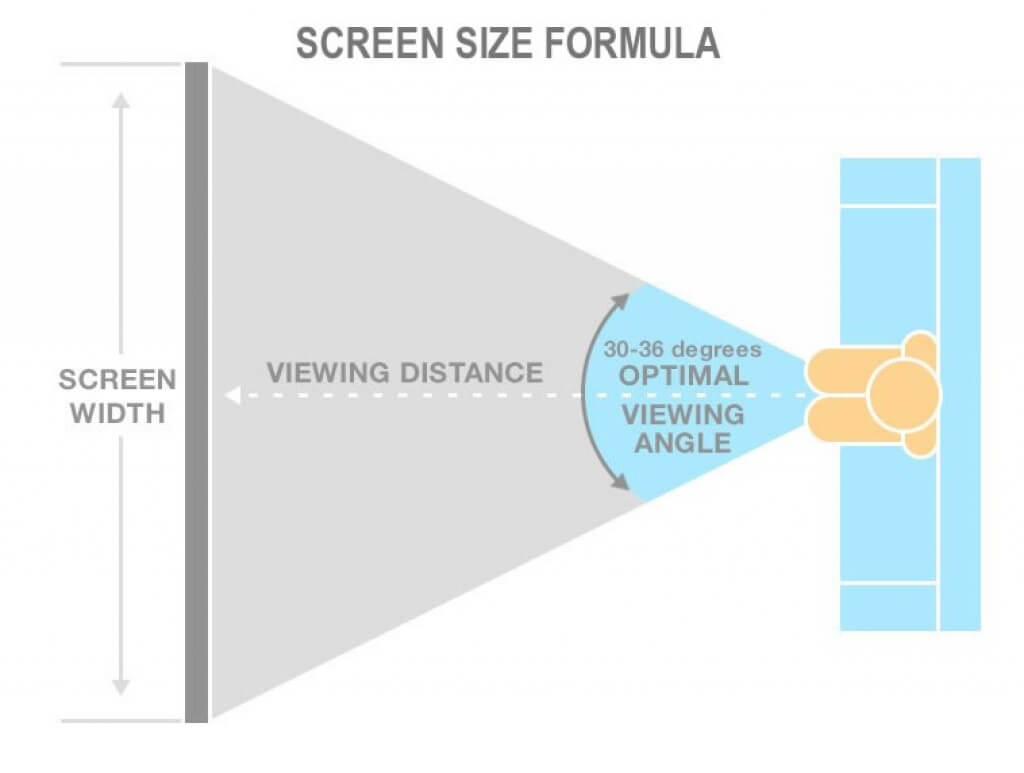How To Size Tv For Living Room
Home » Blog » What Size TV Should I Get? Our TV Screen Size Guide Shows You
What Size TV Should I Get? Our TV Screen Size Guide Shows You
9546 Views

What size TV should I get?
What size TV do I need for my room? How big a TV should I buy?
Those are all common questions we are asked often. I've put together this detailed guide to answer exactly these questions for you.
You will no longer have to wonder what TV size is best. I will show you everything you need to know to calculate the perfect size TV for every room.
So what size TV do I need?
Whether you're getting a TV to watch the current movies, the latest sporting events, streaming your favorite series, or as a gaming TV, the short answer is as big as you can afford.
The long answer is a little more complicated and depends on the room, whether the display is mounted on a wall or not, the seating distance, the viewing angles, and the resolution of the display.
TV Size Quick Tips
1. Determine the TVs location. Display size and resolution is highly dependant on location. Decide the room and mounting first.
2. Decide on your resolution. TVs today offer three resolution options: 1080p, 4K and 8K. Currently, 4K TVs have become the go to for most people, but this can change due to your budget and where the TV will be located.
3. Understand screen size. TVs are measured diagonally from top corner to bottom corner. As a result, a 65-inch TV display is closer to 55 inches wide.
Best TVs By Size Chart - 2021
TV Screen Size – Bigger is Better?

Wonder no longer 'what size TV should I buy.' The size of your TV should only be limited by the size of your television budget.
Wonder no longer what size TV should I buy. The size of your TV should only be limited by the size of your television budget.
I don't know how many times I've heard it. Bigger is better. At least, when it comes to a TV.
Why do you even have an HDTV? You want to feel you are at the championship game. Like you are in the stadium.
You want to lose yourself in the movie or TV show you're watching. As if you were in the theater.
You want to feel immersed in the virtual world of the video game. Suspend reality, at least for a while, and feel embedded in the game.
You want the wow factor. You want to experience the excitement. You want emotional engagement. Isn't that what watching high-definition TV on the largest display is all about?
We all want the big HDTV, but you don't want the television to overwhelm your room. Consequently, you don't want your TV screen size to appear under-developed for your space.
So how do you find the perfect TV screen size? In most situations, our experience has proven that you should choose the largest display your room location, viewing angle, viewing distance, and money will allow.
Many times I've heard people wishing their screen was bigger, but rarely have I heard anyone wish it was smaller.
How To Measure TV Size
Tip: How to measure TV screen size

What is the screen size? The TV screen size is the most important measurement since retailers list new HDTVs by the size of the display.
To accurately determine the screen size, hold the end of your tape measure in one corner and extend it diagonally across to the opposite corner. Ensure your tape measure is inside the TV screen frame, so you only measure the visible screen area.
That distance is your screen size or diagonal screen size.
Consider Room Size and TV Position?
You have a room where you want to put a new television, or you have a TV size you want to buy. You are usually left with one of two questions. What size TV do I need for my room? Or do I have a large enough wall or room for the TV I want?
First, consider where you'll put your new TV. As long as the room's furniture is not permanently attached to the floor and you're willing to move it, you have some flexibility in the size of the TV you can get.
Second, there's also the question of how you plan to set up the TV. Are you using the included stand or use a wall-mount to hang it?
Wall Mount or No Wall Mount?
The first thing to decide is if you want it hung on the wall or not. You need to know this before you head to the store or shop online to buy your HDTV.
If you are placing the TV on a cabinet, it decreases the viewing distance and can cause some viewing angle issues. Also, the flat or curved display size could be limited by the size of the cabinet.
A huge display could look awkward on a small cabinet, and weight limitations could restrict you. Conversely, a long cabinet might make a nice size TV look small in contrast.
If you plan to use a stand mount, be sure to measure the cabinet's length and width. Today's flat screens are much lighter, but it's still a good idea to know how much weight your cabinet can support.
The average flat screen weighs around 45 lbs. However, the weight increases and decreases rapidly based on display style and screen size. Edge-lit LEDs are the lightest models, with an Ultra HDTV being the heaviest.
A mid-sized LED could weigh as low as 25 lbs. On the other end of the spectrum, 75″ Ultra HD resolution QLED or OLED weights an average of around 50+ lbs.

Determining the ideal TV size for the room should be based on the distance you are sitting from the TV, the optimal viewing angle of your peripheral vision, and the screen resolution of the HDTV.
Why is Viewing Distance Important?
The distance you generally sit from the display has a huge impact on determining the best-sized TV for your room. If you want to sit closer, your viewing experience's picture quality could be diminished by certain types of super-sized HDTVs.
The most common resolution offered today is 1080p. For any given size screens, a typical 1080p television has around 2 million tiny individual pixels. The number of pixels will remain constant despite a change in display size.
The pixels will be smaller and closer together on a smaller screen, resulting in sharper picture quality. On a large screen, the pixels are bigger and may start to become visible the closer you come to the screen if the program source is not Blue-ray or HD.
How to Calculate the Viewing Distance
A simple formula for determining the maximum size TV based on how far you sit from the screen divides the viewing distance by 1.5. If your viewing area is 8 feet away from the screen, an HDTV in the 60″ range will help you achieve the optimal cinematic experience.
The resolution of all new TVs is very high. Nearly all new screens are 4k Ultra-high-definition TVs. An increasing number are 8K resolution screens. The new 4K Ultra HDTVs have 4 times the resolution of the 1080p display. You're in the range of 8 million pixels for any size screens. There is less fear of pixelation as you approach the TV since the pixels are a lot smaller and grouped tighter.
To find the optimal size 4K UHD TV display, we suggest a 1 to 1 ratio between viewing distance and screen size. For maximum recommended screen size for 4K Ultra HDTVs, multiply the viewing distance by 15.6. From the same 8 feet viewing distance, theoretically, your screen could max out at 125 inches.
A screen size that big overwhelms most people. Pixelation might not concern you, but you're also well beyond an optimal viewing angle.
Ideal Screen Size and Viewing Distance Guide
Common Screen Size Distance Calculator
| Screen size | Viewing distance range for 1080p HDTVs |
|---|---|
| 40″ | 5.0 – 6.75 ft |
| 43″ | 5.4 – 7 ft |
| 48″ | 6 – 8 ft |
| 50″ | 6.3 – 8.3 ft |
| 55″ | 6.9 – 9.2 ft |
| 60″ | 7.5 – 10 ft |
| 65″ | 8.1-13.5 ft |
| 70″ | 8.75 – 11.7 ft |
| 75″ | 9.4 – 12.5 ft |
| 80″ | 10.0 – 13.3 ft |
| 85″ | 10.6 – 14.2 ft |
| Screen size | Viewing distance range for 4K & 8K UHD TVs |
|---|---|
| 40″ | 3.3 – 5.0 feet |
| 43″ | 3.6 – 5.4 feet |
| 48″ | 4 – 6 feet |
| 50″ | 4.2 – 6.3 feet |
| 55″ | 4.6 – 6.9 feet |
| 60″ | 5.0 – 7.5 feet |
| 65″ | 5.4 – 8.1 feet |
| 70″ | 5.8 – 8.75 feet |
| 75″ | 6.3 – 9.4 feet |
| 80″ | 6.7 – 10.0 feet |
| 85″ | 7.1 – 10.6 feet |

For an immersive viewing experience, viewing distance and viewing angle are important elements in selecting what size TV I should get.
What Is Viewing Angle?
This is the angle created from your nose out to the left and right edges of the display. Viewing angle is a simple but crucial concept in selecting the best television size. Ideally, most of your peripheral vision is filled by the screen image.
The movie theater specification maxim sets 30-36 degrees as the optimal viewing angles. To achieve a "cinematic immersive experience", most of all, you want a screen size that pushes the limits of your field of vision.
THX recommends a display that fills 40 degrees of your field of vision, while SMPTE recommends 30 degrees. To achieve the "immersion effect", we recommend pushing the limit of the larger screen sizes based upon your viewing distance.
It's Time To Buy A New HDTV
You've done it! You now have the concepts and tools to determined the perfect size TV for your room.
It's great to understand the key rules, but every situation and room is different. Ultimately, it comes down to personal preference and taste.
If you want to get an idea of how well your new TV will blend in with your space, Samsung has a great online tool to get an idea of how different size TVs will appear in your room. Take a picture of the wall area your TV will hang or stand from the desired viewing distance (try to include the entire wall).
First of all, before you get started, measure the height and length of the wall, plus the viewing distance. You can choose wall or stand mounted. Then you can select different size Samsung HDTVs to show how each size will appear in your room.
The only thing you have left to decide is what type of screen you are going to get. UHD, LED, LCD, 4K, 8K, or 3D? Flat Panel or Curved? What brand? LG, Samsung, Vizio, Sony, or TCL?
Before you buy a HDTV checklist
- Determine your budget
- Measure the length and height of the wall
- If cabinet mounted, measure the length and width of the cabinet
- If cabinet mounted, determine the weight limit of the cabinet
- Measure the distance between the screen and where you will normally sit
- Decide the type of TV
- Study the chart as a guide for the ideal size range
Best TVs BY Size
- Best 75 inch TVs
- Best 70 inch TVs
- Best 65 inch TVs
- Best 55 inch TVs
- Best 50 inch TVs
- Best 43 inch TVs
Conclusion
Most of all, your TV size and perfect viewing distance are ultimately based on personal preference. I always tend to err on the big side because that's my preference.
If the best size for your room is outside your budget, buy the biggest size TV you can find at an affordable price. Check out our comprehensive tv buying guide to find the best time to buy a tv.
So what size TV did you buy? Di you buy a Samsung, LG, or other brand? Did you buy a TV for watching movies, streaming videos, viewing live sports, or playing video games? Please share it with me in the comments below.
How To Size Tv For Living Room
Source: https://curvedview.com/tv-screen-size-guide/
